 August 2003
August 2003
The Daley News
Greetings again from Daleys. The last month has been full of action here with two new staff coming on board with us and lots of new improvements around the nursery. Firstly I'd like to introduce you to the new crew.
WELCOME TO DANIEL
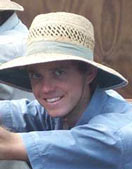 "Hello all ! I would like to say how enjoyable and rewarding it is to be a part of the Dalays nursery team. I am looking forward to learning new skills and building friendships with my new workmates.
"Hello all ! I would like to say how enjoyable and rewarding it is to be a part of the Dalays nursery team. I am looking forward to learning new skills and building friendships with my new workmates.
Here's my quick personality profile-
Pet Loves: Smiles on the faces of my workmates first thing Monday morning
Dislikes: WEEDS
People I admire: Those that stand up for what is right
Passions in my life: Riding clear blue waves in a crystal blue sea on a fine sunny day
Interests: Organic Farming, Gardening, Propagation
Something I would like to achieve in life: Reach the summit of Mt Kilimanjaro!!
Motto: "Whatever your hand finds to do, do it with all your might" Eccl 9:10
Daniel has joined us as a trainee and brings with him experience from working as a farm hand in commercial fruit orchards, particularly subtropical stonefruit. He carries with him, motivation, an enquiring mind and plenty of energy.
WELCOME TO KATH 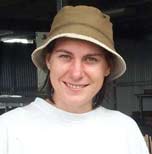
" Greetings fellow plant mad people. Must say its a pleasure to become a pseudo Daley. Look forward to swapping knowledge and stories with all the other forest fans out there. Here's my story
Pet Loves: All things earthy
People I admire: Nelson Mandela
Passions in my life: Art, Music, Dancing, Clean Air, Orchids, Stars and seeing others laugh
Interests: Rainforest regeneration, Growing Food!
Something I would like to achieve in life: To write a book sharing the Natural Art in Forests "
Just one year in the region, Kath clearly displays her genuine passion for plants having identified most of the native plants florishing in her rainforest gulley on her newly aquired property. From the ground to the crown this lass really knows her plants. Kath has taken on the Rainforest Plant Production and will be a bright and friendly face to help you out in our retail section.
 OUR MISSION !
OUR MISSION !
We took the opportunity of this quiet time of year to get away as a team, revise our goals and have some fun outside the nursery. The Daleys Staff Development Weekend, held at the Permaforest Trust at the foothills of the Border Ranges, was an absolute blast. As well as playing numerous crazy games, we took a serious look at our goals as a team and collectively revised our mission statement. This is what we have prepared and what we aim to offer you.
"We, at Daleys Nursery, endevour to provide a professional friendly service and product that exceeds customer expectations and enhances the environment, now and into the future. We do this with integrity and a shared passion within a supportive and progressive team atmosphere, to create a holistic and successful business. "
ON GROUND DEVELOPMENTS
We challenge ourselves be a progressive and evolving nursery. With the fundamental values of sustainable development, we are working to minimize our environmental impact and lead the industry in new environmentally friendly initiatives. Our latest development is our new Slow Sand Filtration System.
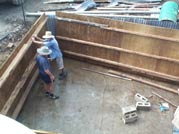 Slow sand filtration technology has been widely used in Europe since the early 1800’s. It was first developed to purify surface water sources for drinking purposes and became a legal requirement in Britain to assist in containing cholera epidemics. Since the mid-19th century, SSF has been widely employed in treating community water supplies in developing countries against water-borne disease and recently there has been a resurgence in its use in small municipal water treatment in the UK and USA.
Slow sand filtration technology has been widely used in Europe since the early 1800’s. It was first developed to purify surface water sources for drinking purposes and became a legal requirement in Britain to assist in containing cholera epidemics. Since the mid-19th century, SSF has been widely employed in treating community water supplies in developing countries against water-borne disease and recently there has been a resurgence in its use in small municipal water treatment in the UK and USA.
The interest and research in using this technology for wider applications is leaping ahead and there are a couple of nurseries around Australia that have tested to system for its suitability. Historically nurseries have relied heavily on chemical treatments to control water-borne diseases prevalent in nursery conditions. While chemical treatments (such as Chlorination/Bromination) have proven effective when used properly, they are relatively expensive and present safety issues to the handlers and the environment.
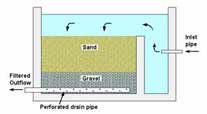 SSF requires no chemicals, no technical equipment necessary and is not threatened by operator error and is therefore a close to foolproof system.
SSF requires no chemicals, no technical equipment necessary and is not threatened by operator error and is therefore a close to foolproof system.
How it Works-
Slow Sand Filtration relies on both physical and biological activity in controlling plant pathogens to filter out pathogens, bacteria and particles.
It consists of a filter bed of sand with a water layer above the bed, providing the head to push the water through the bed. The water passes through the sand from top to bottom. Any larger suspended particles are left behind in the top layers of sand. Smaller particles of organic matter and sediment left in the sand filter are eaten by microscopic organisms including bacteria and protozoa’s that stick to the layers of slime that form around the sand particles. The clean water that passes through the filter is safe to drink. The use of fine grade sand has shown to be efficient in controlling diseases such as Phytophthora, Pythium and Fusarium oxysporum, the most widespread nursery diseases.
It has been a long journey, assessing all the developments of this simple technology and determining the best model for our needs. We are excited to announce that by the end our August, the construction of our system should be complete and we can let the micro-organisms do their work.
ITS PRUNING TIME AGAIN
The winter pruning time is coming to a close, with just a few weeks left before the warmer weather sneaks in and the green begins again to flush. The beautiful blooms of our stonefruit are already bursting out. If you haven't already given your trees their winter snip, I suggest that you sharpen your secaturs quick smart, scoop up your courage and jump right in. Should you require a little extra boost, I have polished up our page on pruning and you are welcome to take a brisk look over it before you head out. Please see the following pages
https://www.daleysfruit.com.au/fruit%20pages/pruning.htm
https://www.daleysfruit.com.au/newsletter/june2001.htm
I have updated the information available on our website covering the tropical peaches, plums, nectarines and apricots available from our nursery.
STONEFRUIT SPECIAL
These low chill varieties need as little as 150 hours chill, that is 150 hours below 7 degrees C in order to bear a good crop of delicious juicy plump fruit. Many varieties are self pollinating and with correct summer and winter pruning it is possible to get a good crop within only two years of planting out. Peaches and Nectarines require heavier pruning that most other fruit trees. Approximately 50% of growth should be pruned from the trees in June and again after cropping in early summer for best results.
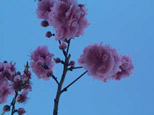 Peaches are white or yellow fleshed and have an excellent flavour. The varieties listed are selected from extensive breeding programs in Florida and are some of the best varieties to date.
Peaches are white or yellow fleshed and have an excellent flavour. The varieties listed are selected from extensive breeding programs in Florida and are some of the best varieties to date.
Nectarines are very similar to peaches in their requirements and characteristics, the only difference being they don't have the distinctive fuzzy skins. The fruit is usually slightly smaller and much brighter in colour than the peach. Some of the promising new varieties include ‘White Satin’, a delicious white fleshed nectarine with excellent taste and aroma and the ‘Sunwright’, an early variety with yellow flesh that is planted quite extensively throughout the subtropics.
Fresh home grown apricots are a favourite to many people, however due to their exact chill requirements they are not heavy consistent croppers in a subtropical climate. Glengary and the locally adapted Bently produce good crops for the home gardener.
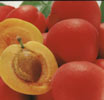 Grafted plum trees are capable of bearing large crops from 1 year after planting. They make delightful ornamental trees due to their mass display of white blossoms during August followed by fruit from October to December. Both self-pollinating and cross-pollinating varieties are available and exhibit very different characteristics. The Satsuma is a self pollinating Japanese Plum that has dark blood red flesh and matures late in the season. The golden flesh plums Gulf Ruby and Gulf Gold benefit from cross pollination and perform well in the subtropics to perform a good quality fruit.
Grafted plum trees are capable of bearing large crops from 1 year after planting. They make delightful ornamental trees due to their mass display of white blossoms during August followed by fruit from October to December. Both self-pollinating and cross-pollinating varieties are available and exhibit very different characteristics. The Satsuma is a self pollinating Japanese Plum that has dark blood red flesh and matures late in the season. The golden flesh plums Gulf Ruby and Gulf Gold benefit from cross pollination and perform well in the subtropics to perform a good quality fruit.
Stone fruit prefer a light warm sandy loam soil that is free draining but can be kept moist. As heavy feeders they require more nitrogen than most fruit trees and prefer an open sunny position. Late frosts and fruit fly are two of the biggest hazard of stone fruit, however netting, mulching and fruit-fly lures can be effective control measures. ‘Green Harvest’ distribute a wide range of pest management products including exclusion devices and fruit fly traps. They offer a mail order purchase system and their product range is available for viewing at www.greenharvest.com.au
REASONABLE RAINFORESTS IN YOUR BACKYARD
The lushious effect of a rainforest planting is sought after by many in the subtropics. While a small back yard planting cannot support the rainforest giants like the magnificent Blue Quandongs and grand Black Booyongs, there are however many native rainforest plants that will suit a condensed rainforest perfect for the back yard.
Download the following PDF file for a table of currently available rainforest plants suitable for such a plan. BACKYARD RAINFORESTS
Photocompetition – Fruit Shoot
We often recieve stories from our customers and fruit mad friends of their latest discovery or their bumper crop. We all know that a picture tells a thousand words so this month we are putting a special offer out there to you all to. Either send in by post or email (as a jpeg file) one or more of your favourite FRUIT photographes and you will be in the draw to win yourself $100.00 worth of plants from Daleys. Dig out the dusty ones or get your cameras ready, the competition closes August 31st at 10:42am!





Our Plants of the Month;
Our new Exotic Fruits-
Velvet Apple - Diospyros discolor
Very beautiful dark red to purple colored fruit with velvet-like skin. Fruit is about the size of an apple, with mildly sweet flavored, somewhat mealy, flesh. Fruits are highly esteemed in some areas, but barely known in most parts of the world
Peach Palm - Bactris gasipaes
This attractive, fast growing palm reaching 12-15m produces clusters of peach-like fruit, which have a sweet and nutty flavour when eaten after cooking. The palm is native to Central and South America and the fruit are often sold at fruit markets.
Jambolan Plum - Syzygium cumini
It is a large evergreen tree, forms a dense cover and has large red/purple fruit which is very juicy, with a sweet to astringent flavour.Eaten fresh or made into ice creams or preserves it is delicious.
From our Bush Foods Section -
Davidson Plum - Davidsonia pruiens
Ahhh!! Davidson’s Plum a true native delight and one of the most delicious of the rainforest fruits. A refreshing potent rainforest fruit that will tantalize the palate. I have used Davidson’s Plums in Christmas puddings, dipping sauces, desserts and salad dressing, and I am sure most of you have heard of or tried Davidson’s Plum Jam. From my experience Davidson’s Plums Couli and Chocolate Soy Ice cream are a match made in heaven.
 When using the plum all you need to do is to wash it, trim the top and cut the plum in half to remove the seeds. There are two seeds and sometimes three. Some plums have a large seed and some, small.
When using the plum all you need to do is to wash it, trim the top and cut the plum in half to remove the seeds. There are two seeds and sometimes three. Some plums have a large seed and some, small.
There are two main varieties that are now grown commercially. The Northern NSW Davidsonia pruiens var. jerseyana which is commonly called the NSW Davidson Plum and the QLD Davidsonia pruiens var.pruriens commonly called the QLD Davidson Plum. The flavour is similar, however the texture and potency of the two fruits are very different. The NSW plum is much richer in flavour and juicier than the QLD variety which is double the size with more fibre and larger seed.
In its natural environment that Davidson Plum grows as an understory rainforest tree 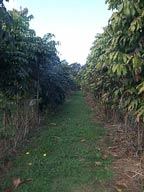 that will grow to 2 metres NSW variety or 3-4 metres QLD variety. And can be pruned to create multiple trunks. The fruit grows in clusters straight from the trunk of the tree looking almost like bunches of large grapes. The NSW plum fruits during December and January and the QLD plum fruits from July to September.
that will grow to 2 metres NSW variety or 3-4 metres QLD variety. And can be pruned to create multiple trunks. The fruit grows in clusters straight from the trunk of the tree looking almost like bunches of large grapes. The NSW plum fruits during December and January and the QLD plum fruits from July to September.
I have seen both varieties growing healthy in full sun with no irrigation once they are 2-3 years old, in drought conditions, however with irrigation you will get much larger and juicer fruit. The QLD plum is considered to be the preferred variety to some chefs and food producers. My preference is the NSW plum which I feel offers a juicer fruit and a richer, fuller flavour. Very refreshing!!
Those who have experienced Davidson Plum jam would have found that it could be used sparingly and still reward you enough flavour to satisfy the palate. As well as its superior tasting fruit and attractive unusual appearance of the tree, the tree has been listed as Endangered by the NPWS and it would be of great benefit to maintaining environment diversity to have one or two of these trees in your garden or bush regeneration planting.
The trees listed above and many more are available at Daleys Nursery. See our website at https://www.daleysfruit.com.au.htm and go straight to the shopping trolley to order these plants or call in and see Emma at the Nursery for more information.
|
Davidson Plum Couli |
|
|
Method: |
|
Davidson Plum Article and Recipe by Ward Gunn. Bush Food Chef
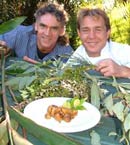
THE NATIVE FOOD CONVENTION IS BACK
For all bush food enthusiasts and anyone interested in a fun day out, Ward and local Bush Food Horticulturalist Peter Hardwick will be conducting a Native Foods and Herb Field Tour on Sunday the 17th of August in conjunction with the Lismore Herb Festival, Northern NSW. This tour will introduce you to native greens and herbs as well as rainforest fruits and spices from both a horticultural and industry perspective utilising the farmer experience in the field sites visited. Ward will also delight you with the culinary experience of bush foods with a nourishing morning tea and Lunch. For more information or to enrol in the day check out the following website
www.acenc.com
For more details on the Herb festival see www.herbfestival.org
Next Issue
Olive Growing
and
Ground Preparation for Fruit Trees





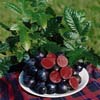 Ingredients:
Ingredients: